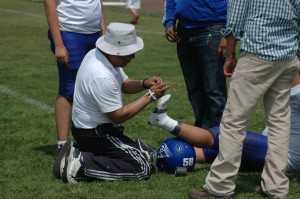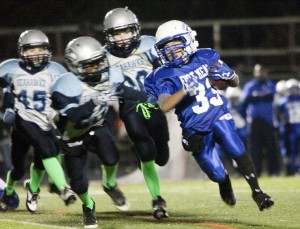by Keith Cronin
If you are a coach or trainer you have probably heard this answer from a healthcare provider when you ask a question as simple as, “How hard can I push an athlete after rotator cuff surgery?” And whether it is a rotator cuff, a patellar tendon, or perhaps a strained neck muscle, you probably want to know more about your athlete’s injury and what you can do to help prevent problems in the future. Seems like a simple answer. Right?
The problem is “Well, it depends…” takes a long time to explain if you are a physician, athletic trainer, or physical therapist. What the patient is usually met with is a couple of quick sentences or an extensive anatomy, biomechanics, or physiology lesson that he or she should be getting continuing education credits for. So in this article I am going to break down some of the important things that a physician or rehabilitation specialist wants you to know about pushing an athlete that recently had an injury.
Everyone is Unique…Is Some Way, Shape, or Form
Probably the most difficult part of “Well, it depends…” is the individual history and make up of the athlete you are working with. Remember your last visit to the doctor? Remember all those forms? Aside from simply irritating you, there is a reason for all that information. Medical history plays a big role in what a healthcare provider will say an athlete should or should not do!
Consider the following: when a young athlete arrives in my office, aside from the injury and pain (to be discussed in a little bit), here are all the things that I take into consideration over the course of five minutes:
- Age
- Gender
- General well-being
- History of Pain conditions (ex. Complex regional pain syndrome)
- Body type / Stature
- Family dynamic
- Previous injuries
- Attitude
- Previous sports experience
- Level of competition
- Previous strength and conditioning history
- Previous medical treatments
- Surgical procedures
- Anatomical abnormalities
- Medications
- Risk Factors (ex. Type II Diabetes, Genetic disorders, neurological disorders)
This is a short list, even before getting to the objective and subjective assessment. A 14-year-old female cross country runner with good family support, no current medications, generally good body conditioning, no bony or anatomical abnormalities, and a good attitude when it comes to rehab with an Achilles tendon strain is probably going to work back just fine. That same 14-year-old female cross country runner that has had five Achilles tendon injuries, barely stretches, has a painful “pump bump” on the back of the heel, and parents who never speak to the healthcare provider is not likely going to return to sports or start training as fast as the previous example.

Not all Injuries are Equal
Once an athlete is discharged from medical care, there are several considerations when it comes to returning them back to field.
- Nature of the Injury – Was this injury due to overuse, a random accident, or because of poor body mechanics? Overuse injuries require particular attention to avoid causing the same situation that got the athlete there in the first place. Acute injuries, such as a sprained an ankle, may return faster—particularly if the swelling, pain, and limited motion and strength are no longer a problem. But what if that ankle has been sprained for the fifth time? Maybe there is some sort of mechanical issue or balance deficiency going on. The athlete may seem fine but really, 14 years old and five ankle sprains? More time and attention may be needed to keep this athlete off the injured reserve list
- Location of the Injury – In the young athlete, joint pain is particularly concerning. With adults, the effects of time and high mileage tend to wear away cartilage, causing more bouts of pain, instability, or weakness. But with a 12-year-old female lacrosse player? Not so much. Pain and injuries associated around joints—particularly that still present with swelling—need to be treated with great attention. While muscles are forgiving, the articular surfaces of say the patella are not. A mid-shaft humerus contusion is much less concerning than say medial elbow pain with throwing.
- Severity of the Injury – Are we talking a grade I ankle sprain versus an ACL tear? An athlete who sprains an ankle and is walking normally within a few days is far less of a concern than an athlete that has been on crutches for three weeks. Children tend to heal faster than adults, but please note while there is greater capacity for improved physiological turn over of tissue from good to bad, don’t simply just say, “Eh, she will be fine.”
Tell Me Where it Hurts?
Pain is probably on every trainer’s and coach’s mind. Pain, honestly, is probably what you are concerned about most. These questions go through your head:
- How much pain is okay?
- Squats are okay, but lunges hurt a little. Is that normal?
- If her knee hurts, should I let her run?
- When my athlete lifts 10 pounds overhead, there is a little ache. Is that okay?
- There is a some pain with throwing. Should I have my pitcher stop?
Pain is not as simple as “yes or no.” Why is that? Because honestly, if athletes were to stop when faced with any pain with anything then sports would not exist. When it comes to pain, there are a several factors to consider
- Frequency – How often does the pain occur?
- Duration – When it hurts, for how long does the pain persist?
- Intensity – Barely hurts, causes me to stop what I am doing, where is the paramedic?
- Onset – Time of day or activity?
- Quality – Burning, stabbing, radiating, pinching, catching, numbing?
- Location – Does it hurt on the side of the knee, under the knee cap, or above the knee joint?
- Activity of Daily Living – Does it hurt to walk, sleep, go up and down stairs, squat?
- Sports Mechanics – Hurts the elbow throwing after 30 pitches and causes the arm to drop below the shoulder plane
An athlete who has no problem with stairs but some knee pain after 45 minutes of running is more likely a conditioning issue. An athlete who is dying to get back on the field and can’t squat, has burning pain to the foot six times a day, and cannot go up the stairs is another issue.
Putting the Pieces Together
Now looking at the information above, you can probably conclude there are an infinite number of possibilities when it comes to the question, “How hard can I push an athlete after rotator cuff surgery?” I imagine what you are experiencing now may be something along the lines of “How am I going to figure this out?” Here’s the great news: You don’t have to!
As a coach or trainer, what you do need to know is what questions to ask. Unfortunately, getting a physician on the phone is sometimes difficult. Once you do, getting to the point is critical. Generalized questions lead to rambling, non-specific answers. Next time you speak with a healthcare provider about your athlete, stick to this script:
First, before anything else, you have to get consent from the parents. This may involve a parent sending an email or signing something that allows you to speak directly with the doctor. It’s HIPPA. It’s the law. To me, this is where a lot of information is lost due to this legal hurdle. If that is not possible, then you must give the script to the parents to ask. Unfortunately this can be a “telephone game” situation where some information is lost along the way. Do the best you can.
The Script: Your Three Questions
“I am a (coach/trainer) that is working with your patient to get (him/her) back to playing (fill in sport). She was recently released from your care and before starting a regimented return to sport program I had three questions to ask you. Do you have a few minutes to speak?
— The healthcare provider may ask you to email your questions or call back at another time but stating there are three questions lets him or her know that you have a game plan. Likely in the end, it will lead to more questions and talking.
1: “Specific to this athlete, is there any information, concerns, or medical background that would prevent progressing safely towards returning to (insert sport) over the next (pick time frame…say six weeks)?”
— Here you have asked about anything that is particularly concerning and believe me if there is something off the wall, that info is coming out. You suggested a time frame and given the practitioner a chance to alter that time frame. If you do not give a specific time frame, then you will get another generalized “Well…it depends” answer.
2: “Specific to this injury (or surgery), is there anything that I should watch out for to refer back to your care?”
— You have now offered the healthcare provider a chance to offer their advice or guidance. There may be a specific procedure done to reconstruct a knee that the physician may inform you about. The athletic trainer or physical therapist may be concerned about that same knee but now tells you about some other concerns with the opposite foot. Again, this gets the conversation going.
3. “Are there any sport-specific training regimens that you would prefer? Are there also any that you recommend this athlete not participate in?”
— For example here, if an athlete had severe patellar tendonitis and was a catcher, I would inform the youth fitness specialist, strength coach, or sport coach to stop all weighted squats. Even if the athlete was pain free with catching, I still wouldn’t want that added back in until after baseball season. Remember, your healthcare providers hear the same stories everyday of what gets people into medical care. This is a great time to share this information.
Healthcare providers are seeing more people in less time every single year. Believe me, we care about everyone that comes through the door and sometimes information falls in the cracks. As a youth fitness specialist, strength coach, or sport coach, you want what is best for your athletes. In order to best facilitate that, having a game plan when it comes to addressing injured athletes is important. In healthcare, once a patient is good enough to discharge, it is common that it is on to the next individual. Its not because healthcare professionals are interested in an athlete’s return to sports, but frequently another patient is awaiting care.
Hope this helps.
Keith J. Cronin, DPT, OCS, CSCS



Great information to know – Thanks!